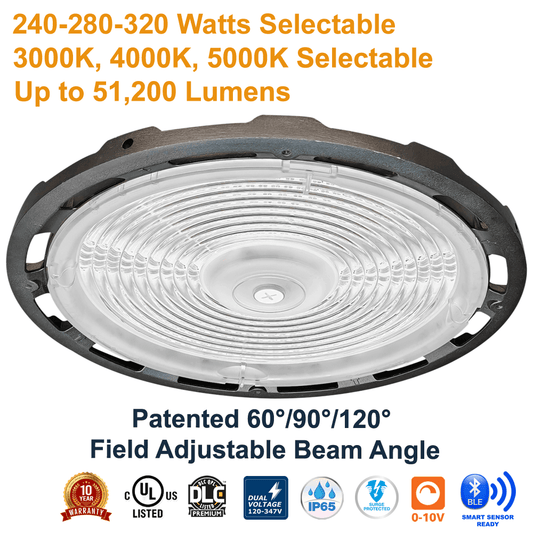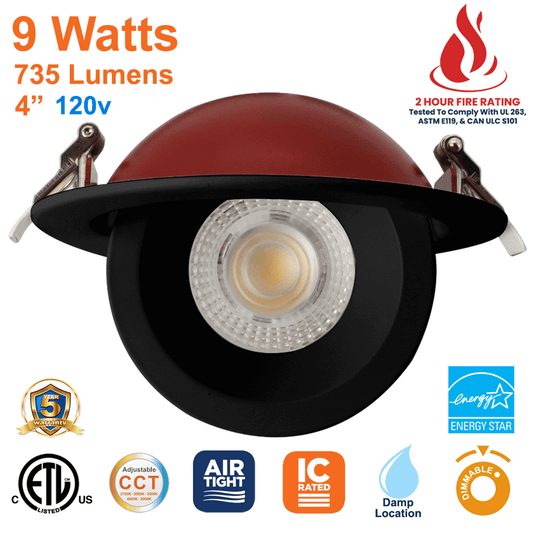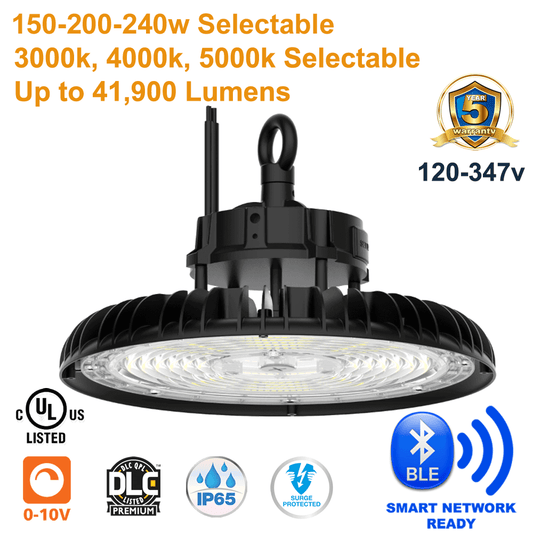In the ever-evolving domain of LED Commercial Lighting, L70 stands out as an important metric. It's akin to the "pulse" of a light fixture, offering insights into its longevity and vitality. But before we traverse the intricate lanes of L70, let’s first look at the foundational premises of LED lighting.
The Paradigm Shift in Lighting
LED technology has revolutionized the way establishments illuminate their businesses. From the robust LED Wall Pack to the sleek LED Panel Light, LED light fixtures champion both energy efficiency and longevity. Central to this success story is the unceasing innovation spotlighted by standards like L70.
"LED Lighting isn't just about illumination. It's a narrative of innovation, energy conservation, and the future of lighting."
Decoding L70
L70 refers to the duration, in hours, it takes for an LED fixture to diminish to 70% of its initial lumen output. A lumen, for the uninitiated, quantifies the brightness emitted by a luminaire. If you're keen to understand lumens further, our comprehensive guide on lumens offers a deeper look at the subject.
The Genesis of L70
The International Illumination Commission has championed L70 as a standard in LED lighting, echoing its significance in discerning light depreciation. But what's the science behind its calculation?
L70 emerges from testing a selection of LEDs and pinpointing the duration until half of them fall to 70% of their original brightness. This criterion owes its inception to the intriguing fact that the human eye struggles to recognize a dip in light's intensity until it has decreased by approximately 30%. It's a mesmerizing confluence of biology and optics, highlighting the disparity between quantitative data and human perception.
For instance, LED High Bay Lights are celebrated for their commendable L70 metrics, attributing this to their adept design and superior thermal regulation. Contrarily, LED Pot Lights often possess marginally lower L70s. This is attributed to their smaller surface area and typical placement in insulated ceilings, ushering in elevated operating temperatures.
L70 Amidst its Counterparts
L70 is not alone on the stage of LED metrics. Its contemporaries include L80, LM80, and TM-21. While L80 symbolizes the time taken for fixtures to reach 80% of their initial output, LM80 charts the lumen depreciation of LEDs as components. TM-21, on the other hand, prognosticates long-term lumen maintenance, drawing from LM80 data.
A common quest in our pursuit of sustainability is whether dimming an LED can elongate its L70. In brief, it can. By reducing the thermal stress on LEDs through dimming, their lifespan increases. As a result, the integration of Networked Lighting Controls, notably state-of-the-art Bluetooth Mesh Wireless Networked Lighting Controls, like those developed by Keilton LiteTrace materializes as a strategic move for both conserving energy and amplifying LED durability.
Stay with us as we venture further into L70, demystifying the factors that influence LED endurance and sustainability. For lighting aficionados, our comprehensive guide on LED Corn Bulbs beckons, offering insights into these fantastic LED retrofit lamps.
Beyond the Numbers: Understanding L70's Practical Implications
It's one thing to grasp the science and metrics of L70, but comprehending its real-world significance for Commercial LED Lighting and Industrial LED Lighting holds paramount importance. This understanding is pivotal for businesses, contractors, and even homeowners eyeing LED solutions for longevity and efficiency.
Demystifying L70 B50
A frequently encountered term amidst L70 discussions is L70 B50. But what does it signify? Essentially, when an LED fixture is labeled with an "L70 B50" metric, it indicates that when half of a certain LED batch reaches its L70 lifespan, the other half remains brighter than 70% of their initial output. This is a powerful testament to the consistency and quality of the product, especially for products such as LED Area Lights and UFO LED High Bay fixtures, which are crucial for maintaining a certain luminosity in their applications.
Perception Versus Reality: The 100,000-Hour Myth
One of the prevalent myths is that an L70 of 100,000 hours implies the LED fixture will work for that span. The truth is nuanced. While the LED chips may still produce light after this period, their luminance will be 70% of its original capacity. Additionally, other factors can potentially shorten the stated L70 of an LED fixture. Variables like operating temperature, voltage fluctuations, and driver quality play pivotal roles. For an in-depth understanding of LED drivers, feel free to explore our guide on what an LED driver does.
"L70 is not an expiration date for your LED but rather a marker of when its luminosity begins to decline. Always consider all factors influencing its performance."
Dimming and Its Impact
As illuminated in our previous segment, dimming an LED fixture can potentially extend its L70. This is particularly valuable for interior spaces like those with LED Office Lights where varying luminosity levels cater to different moods and functions.
However, a pertinent question arises: If dimming is beneficial, can the addition of Networked Lighting Controls augment this advantage? The answer is a resounding yes. By enabling precise control over lighting intensity, Wireless Networked Lighting Controls can significantly optimize an LED's operational lifespan while facilitating even greater energy savings.
LEDs and their Environmental Interactions
Interestingly, an LED chip's L70 can vary based on its fixture. Environmental factors, like moisture and heat, can impact an LED's performance. That's why products like LED Corn Bulbs, designed to be used in outdoor settings, undergo rigorous testing to ensure they sustain their luminance despite external adversities.
Why No Eternal Glow?
While LEDs are heralded as the paragon of lighting longevity, they don't last forever. Their components degrade over time, and the materials used in the diodes naturally deteriorate. This, coupled with external stressors like voltage fluctuations and temperature, gradually diminishes their light output.
In our concluding segment, we'll further decode the longevity and limitations of LEDs, providing valuable insights for businesses, consumers, and lighting enthusiasts. Join us as we continue this illuminating journey through the maze of LED standards and innovations. For readers eager to understand the core of LEDs, our article on What is an LED? offers a comprehensive perspective.
Closing the Loop: Unraveling the Remaining Mysteries of L70
As we continue shedding light on L70, a few more intriguing facets emerge about this paramount standard in the world of LED Lighting.
Comparing L70 with L80 and LM80
While L70 is a well-recognized standard, you might also encounter terminologies like L80 and LM80 when exploring the LED realm. So, what's the difference?
-
L70 vs. L80: While L70 denotes that an LED will maintain 70% of its initial light output, L80 refers to an LED retaining 80% of its initial light output. If one LED is rated with an L70 of 50,000hours, and another LED is rated with an L80 of 50,000hours, the L80 rating implies a longer functional lifespan than L70 before significant light degradation.
-
L70 vs. LM80: LM80 is a test procedure for evaluating the lumen depreciation of LED light sources. It provides a standardized method to measure the lifespan of an LED. In contrast, L70 is the outcome derived from such tests.
-
L70 vs. TM-21: TM-21 is a method for extrapolating long-term lumen maintenance predictions from LM80 test data. While LM80 might provide data for 6,000 hours, TM-21 can project the LED's performance for, say, 50,000 hours.
LED's Longevity: Fixture Matters
One might assume that an LED's L70 would remain consistent across all fixtures. However, this isn't the case. For instance, why do LED Pot Lights generally have lower L70s than LED High Bays? The answer lies in the design and thermal management of the fixture. High Bay lights, often found in commercial and industrial settings, are designed for optimal heat dissipation. On the other hand, Pot Lights, due to their compact design, may not dissipate heat as efficiently, leading to a quicker lumen depreciation.
A Question of Perception
You may wonder if these standards and percentages truly matter to the human eye. Is it factual that the human eye cannot detect the difference in a light’s output until it has reduced by 30%? Research affirms this assertion. Our eyes are remarkable but not always keenly sensitive to gradual changes in brightness. This physiological trait fortifies the importance of the L70 benchmark, ensuring that by the time we notice a decline in light quality, the LED has served a commendable duration.
LEDs: Durable, but not Immortal
Despite their remarkable longevity and efficiency, LEDs are not impervious to wear and the ravages of time. Components wear out, materials degrade, and external conditions play their part. Nevertheless, with proper care, understanding of standards like L70, and integration of advancements like Networked Lighting Controls, we can maximize their potential and contribution to a brighter, greener future.
And there you have it, a comprehensive guide to L70, a hallmark of LED durability and efficiency. For those looking for even deeper insights into the world of LEDs and lighting controls, we invite you to peruse our LED Network Blog where enlightening discoveries await.




























